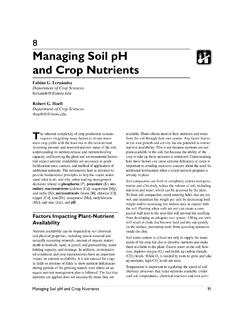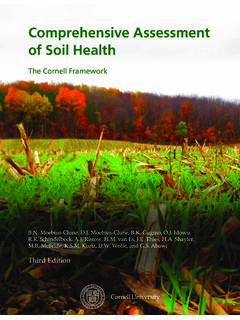Transcription of NUTRIENT DEFICIENCY SYMPTOMS - mgofmc.org
1 -1- NUTRIENT DEFICIENCY SYMPTOMS Barbara J. Bromley, Mercer County Horticulturist 10 Of all of the SYMPTOMS and signs of trouble in plants, possibly the most overlooked are NUTRIENT deficiencies . The interrelationship between a NUTRIENT 's availability and soil pH, air and soil temperature, available moisture, excesses of other nutrients, soil organic matter and soil mineral content are complex. Sometimes, though, visual SYMPTOMS can be used to identify possible problems. Ideally, deficiencies are determined by soil testing and/or plant tissue analysis. Soil testing is the best way to accurately determine whether primary NUTRIENT levels are optimum for plant survival and growth. Nitrogen is often a special test, but is generally applied to most crops by standardized rates.
2 A rule of thumb for gardeners is that if plant matter (leaves, branches, grass clippings, weeds, etc.) are removed from a site, something needs to be put back to replace those lost nutrients. MACRONUTRIENTS: Primary NITROGEN (N) Nitrogen is mobile in plants. The mobility in soil is dependent on the chemical form of the element used. Organic N is not available to plants until it has been converted to an inorganic form by soil bacteria. Uptake inhibited by high phosphorus levels. N/K ratio is important: high N/low K favors vegetative growth; low N/high K promotes flowering and fruiting. Nitrogen is needed for vigorous vegetative leaf and stem growth and dark green leaf color (chlorophyll production).
3 It feeds soil microorganisms as they decompose organic matter. It is part of proteins, enzymes, chlorophyll, and growth regulators. DEFICIENCY SYMPTOMS General: Stunted growth and shorter internodes, small pale yellow leaves. Plant may be a light green. Older leaves affected first. Reds and purples may intensify in some plants. Crops: Older leaves yellow, then dry, fire, or shed. Tomatoes show purpling of veins. Turf: Grass light green or yellow-green. Leaf dies starting at the tip. Death of older leaves. Broadleaf plants: Leaves are uniformly yellowish-green; this color is more pronounced in older leaves. The leaves are small and thin, have high fall color, and drop early. Shoots are short and smaller in diameter than usual.
4 Shoots may be reddish or reddish brown. Flowers bloom heavily, but may be delayed. Fruit set is light. Fruits may be highly colored, early to mature, and small. Conifers: Needles are yellowish, short, and close together. Older plants exhibit poor needle retention. Lower crowns may yellow, while upper crowns stay green. Sources: Organic: dried blood or blood meal (10-0-0), fish meal (5-3-3) and fish emulsion (4-1-1), cottonseed meal (6-2-1), sewage sludge, fresh bat guano (10-3-1), coffee grounds ( 2), crab meal ( ), feather meal (11-0-0), hoof and horn meal (12-2-0), soybean meal ( ). Inorganic (NH4): anhydrous ammonia (82-0-0), urea (45-0-0), ammonium nitrate (34-0-0), ammonium sulfate (21-0-0), diammonium phosphate (18-46-0), ammonium phosphate (10-34-0) Inorganic (NH3): sodium nitrate (16-0-0), calcium nitrate ( ), potassium nitrate ((13-0-44) Slow-release: urea-formaldehyde, thiourea (sulfur-coated) N excess: Causes succulent, but often-spindly growth, dark green color.)
5 Decreased disease tolerance. If very lush, low or no flowering and fruit set. -2- PHOSPHORUS (P) Phosphorus is very mobile in plants; relatively immobile in soil and does not leach. It is stored in seeds and fruit. It is most readily available to plants between a pH of 6 and (unavailable in very acid or alkaline soils). Found in greatest concentration in sites of new cell growth. Phosphorus absorption is reduced at low soil temperatures. Phosphorus is necessary to stimulate early root formation and growth, hasten crop maturity, stimulate flowering and seed production, give winter hardiness to fall plantings and seedings, and promote vigorous start (cell division) to plants. Phosphorus has a role in fat, carbon, hydrogen, and oxygen metabolism, in respiration, and in photosynthesis.
6 DEFICIENCY SYMPTOMS General: Red or purplish color (anthocyanin pigment) in leaves, especially undersides. Death of tissue or necrosis may follow. Root growth poor. Lower stems may be purplish. Plants may exhibit stunting and delayed maturity. Loss of lower leaves. May exhibit reduced flowering. DEFICIENCY is often a problem in cool soils in early spring. Crops: corn has purplish tint, legumes bluish green and stunted, tomato has yellowing of leaves, appearance of purpling on underside of leaf, and delayed maturity. Turf: reddish-purple cast appears from the tip of the leaf blades (especially apparent in cool weather), dull blue-green color, poor growth. Sod slow to knit. Fescue leaves have a cupped appearance.
7 Broadleaf plants: Leaves are green to dark green. Veins, petioles, and lower surfaces may become reddish, dull bronze, or purplish. Foliage may be sparse, slightly smaller than normal, and distorted. Leaves drop early. Shoots are normal in length unless the DEFICIENCY is severe, but they may be small in diameter. Conifers: Needles turn purple in young seedlings, starting at the tips of lower needles and progressing inward and upward. Few or no secondary needles may appear. Needles die, starting in the lower regions and spreading upward through the tree. Buds may set early or seedlings remain dormant longer than usual. Older trees take on a dull blue or gray-green color. Sources: Organic: bone meal (1-11-0), animal manures (vary) Inorganic (rock powders): colloidal phosphate (0-2-2), rock phosphate (0-3-0) Inorganic synthetic: triple superphosphate (0-46-0); superphosphate (0-16-0); monoammonium phosphate (11-48-0), diammonium phosphate (18-46-0) P excess: Shows up as micronutrient (Zn, Fe, or Co) DEFICIENCY ; high P also interferes with N absorption.
8 POTASSIUM (K) Potassium (potash - K2O) is highly mobile in plants, and generally immobile in soil. Tends to leach. Potassium promotes vigor and disease resistance, helps development of root system, improves plant quality, and increases winter hardiness due to carbohydrate storage in roots. Increases protein production, and is essential to starch, sugar and oil formation and transfer and in water relations. DEFICIENCY SYMPTOMS General: Bronzing and dying of leaf margin. Some spotting between veins; chlorotic with brown spots throughout leaf. Tendency to wilt readily. Stunted internodes and roots. Turf: Yellow-streaked leaves, followed by browning and death of tips and margins. Wilts sooner during droughts, lowered resistance to disease and cold injury, reduction in turf density.
9 Broadleaf plants: Leaves exhibit marginal and interveinal chlorosis (yellowing), followed by scorching that moves inward between the main veins to the entire leaf. Older leaves are affected first. Leaves may crinkle and roll -3- upward. Shoot tips die back late in the season. Shoots from lateral buds result in zigzag growth that is short and bushy. Flower buds are few. Fruit is small and poorly colored. Conifers: Older foliage takes on a dark blue-green color that progresses to yellow and reddish-brown; finally, necrosis (death) occurs at needle tips. Needle retention is poor; needles are often stunted. Seedlings have short, thick, abundant buds; Frost injury is frequent. Sources: Organic: kelp meal ( ), wood ash ( ), plant residues Inorganic (rock powder): granite meal (4% total potash), greensand (7% total potash), langbeinite (sulfate of potash magnesia, 0-0-22 +22% S+11% Mg), muriate of potash (0-0-60), Inorganic: sulfate of potash (0-0-50), potassium nitrate (13-0-44), sul-po-mag (0-0-22 +22% S +11% Mg) K excess: May create an N DEFICIENCY .
10 Very high K levels can create a magnesium DEFICIENCY . MACRONUTRIENTS: Secondary CALCIUM (Ca) Calcium is immobile in plants, and relatively immobile in soil. Moderately leachable. Sometimes difficult to differentiate between calcium DEFICIENCY and magnesium toxicity. Calcium is necessary for cell elongation and division, protein synthesis, root and leaf development, and plant vigor. It influences intake of other nutrients and increases calcium content of plants. Important in cell wall structure and as an enzyme activator. DEFICIENCY SYMPTOMS (relatively rare) General: Newest leaves hooked. Inhibition of bud growth; Terminal bud dies. New leaves are yellow, while older leaves dark green.





